I want to share with you a process that’s fascinated me for some time, but I wasn’t ready to share my discovery until I’d had enough experience with it.
That discovery is the lacto-fermentation of chicken feed.
In a nutshell, fermented chicken feed is probiotics for your chicken. It’s a wet mash (the chicken keeper’s term for moistened food) created by lactic acid fermentation (the same type of fermentation that occurs naturally in sauerkraut).
Just like kraut, it contains all the bacteria that’s good for your gut: Lactobacillus, Leuconostoc, Pediococcus, and other beneficial bacteria and yeasts.
I’ve been fermenting my chicken feed off and on since 2012, when I wanted to go through a 50-pound bag of scratch grains quickly and efficiently.
(Learn from my mistake: Do not buy 50 pounds of scratch if you have a small flock of chickens that forages most of the day. They will peck and scratch the ground regardless, and if you already feed them a healthy whole-grain diet, they will simply ignore the scratch you toss on the ground.)
How Does Lacto-Fermentation of Your Chicken Feed Work?
The first day of soaking your grains greatly improves their digestibility by reducing the phytic acid and enzyme inhibitors found in all grains, seeds and legumes.
By the second day, lactic acid bacteria begins the process of fermentation by consuming the sugars in the grains and multiplying in great numbers, producing lactic acid. The lactic acid, in turn, makes the environment unsuitable for bad bacteria, leaving behind only beneficial microbes.
As long as the grains stay submerged in their lactic acid “bath,” they will be preserved indefinitely (though there comes a point when the grains can become too sour and thus, not very tasty… just ask anyone who has had over-fermented kimchi).
Why Ferment Your Chicken Feed
We all know that lacto-fermented foods are good for us; yogurt, sauerkraut, kimchi, and kombucha are among the foods touted for their nutrient-dense and enzyme-rich benefits to our health.
Lacto-fermentation is an anaerobic process that preserves and enhances food. Lacto-fermented food contains live Lactobacillus, a beneficial bacteria that helps normalize the acidity in our stomach, provide digestive balance, aid in the absorption of nutrients, neutralize toxic compounds, and strengthen overall immunity.
When it comes to chickens, fermented feed has been found to increase egg weight, shell weight and shell thickness; boost the chickens’ intestinal health by forming a natural barrier to acid-sensitive pathogens like E. coli and Salmonella; and lowered their consumption of feed (due to their bodies digesting the fermented feed more effectively), according to a British Poultry Science study from 2009.
Another 2009 study by the African Journal of Biotechnology concurred that fermented feed reduces the level of anti-nutrients found in the grains and seeds, and greatly improves the bioavailability of vitamins and minerals during digestion.
Not only does fermentation preserve the vitamins in your grains, it also creates new vitamins, primarily B vitamins like folic acid, riboflavin, niacin, and thiamin.
In short, fermenting your chicken feed leads to better eggs, better hen health, and lower feed costs. Less feed also means less poop, which none of us can complain about!

How to Ferment Your Chicken Feed
You can ferment any feed you currently give your chickens, whether it’s crumbles, pellets, scratch, or whole grains and seeds. The higher quality your feed, the more your chickens will gain from lacto-fermentation.
Try fermenting my homemade whole grain chicken feed (with or without corn), but leave out the brewer’s yeast as that will introduce alcoholic fermentation (whereas we want lacto-fermentation).
For my flock of three hens, I use a gallon-size glass jar. Larger flocks may require five-gallon buckets or storage bins, so long as they come with a lid.
If you can only source a plastic container, try to ensure it’s BPA-free. The acids in lacto-fermentation can increase the chances of BPA leaching into your liquid, and while there hasn’t been any concrete studies on how much BPA is actually leached, I’d rather not take my chances.
Fill your container about one-third to one-half full with the feed of your choice. You want to leave room for the grains to expand.
Add enough dechlorinated water to cover the grains by a couple of inches. Why dechlorinated water? Because most municipal water — the stuff that comes out of your tap — contains chlorine and chemicals designed to kill bacteria, including good bacteria.
You can use filtered water for lacto-fermentation, or simply set your tap water out for 24 hours to allow time for the chlorine to evaporate.
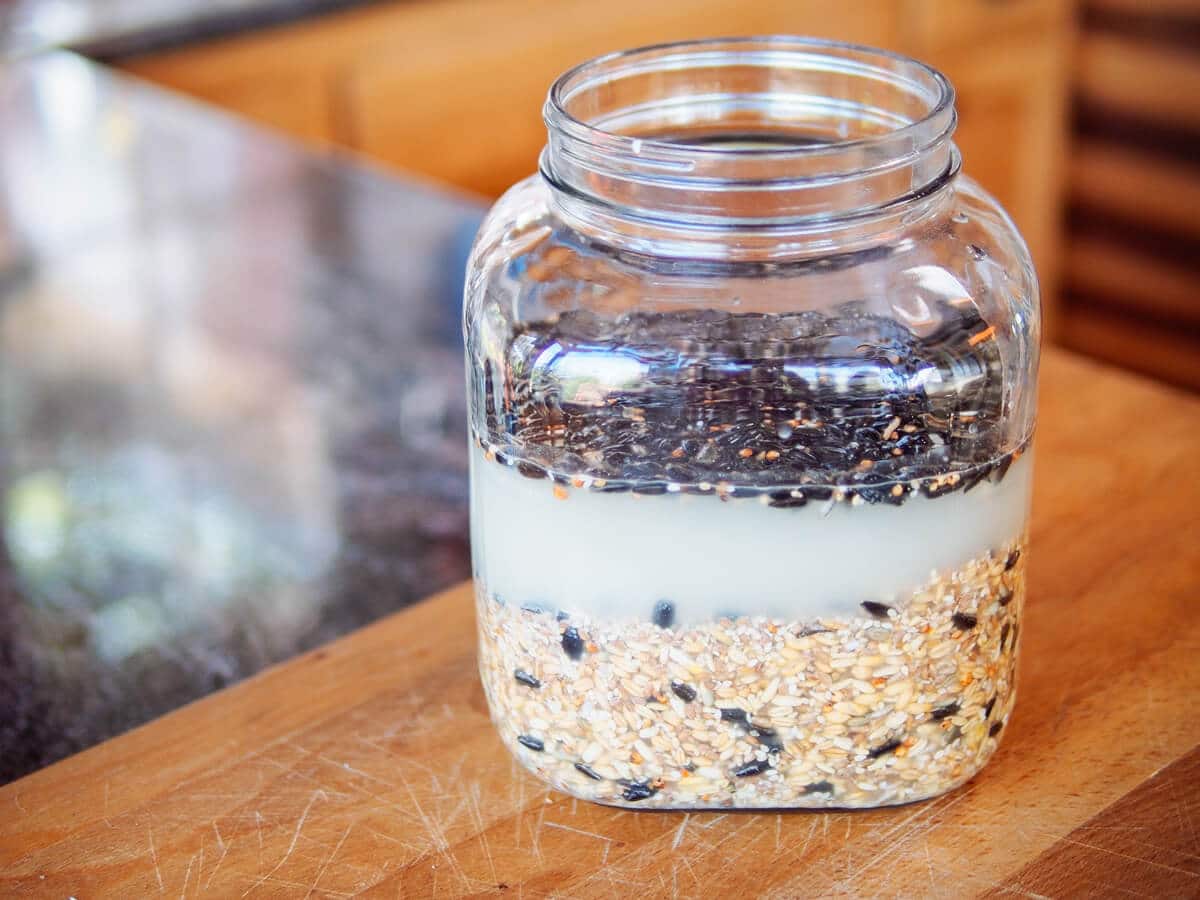
Place a lid on your container and leave it out at room temperature for three to four days. At least once a day, or whenever you remember, give the grains a stir and add more water as needed to make sure they stay submerged.
When you start to see a layer of bubbles on the surface of your liquid, voilà — you have lacto-fermentation in process. The bubbles are the off-gassing of carbon dioxide by lactic acid bacteria.
The water will appear cloudy and the top layer may seem filmy and foamy, but rest assured these are the normal effects of all that bacteria at work. You can simply stir the “scum” back into the feed when you see it.
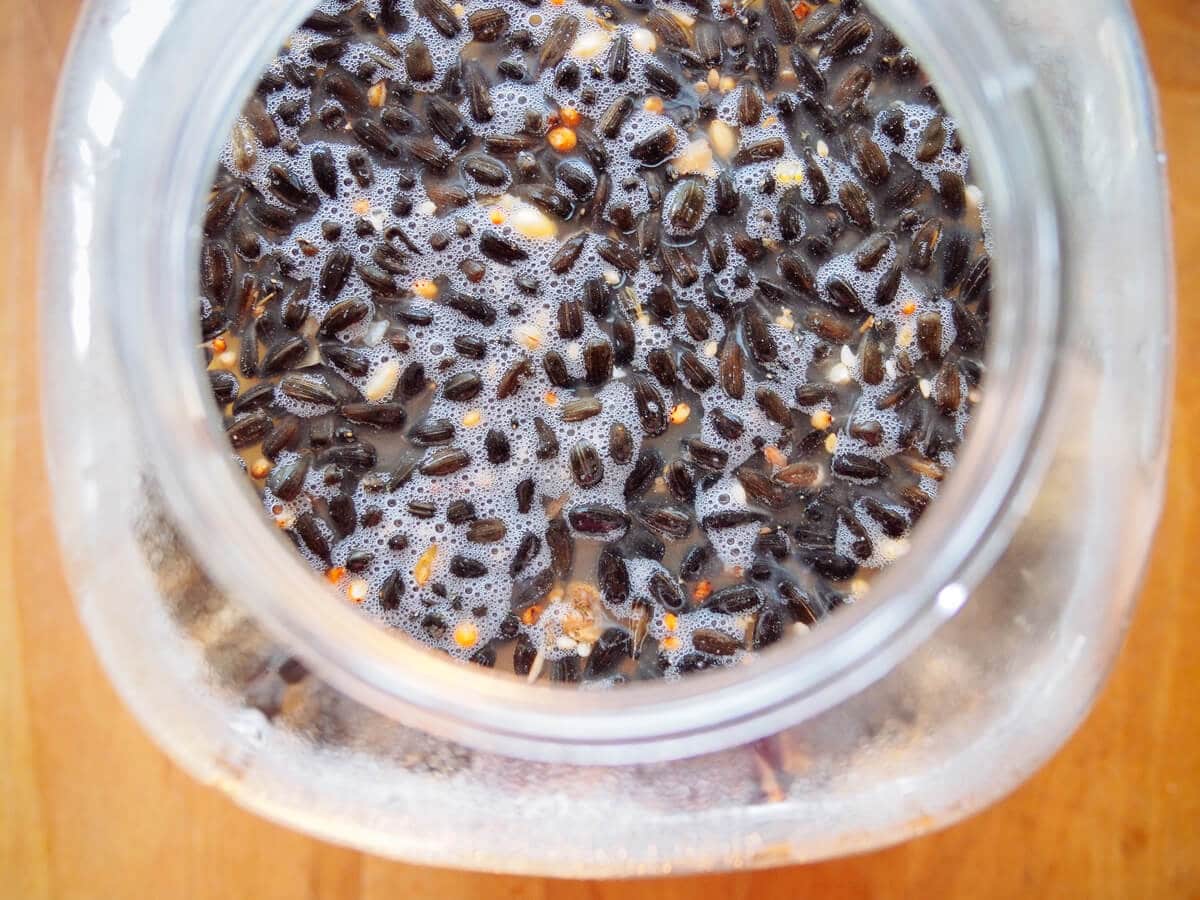

Properly fermented feed actually smells pretty good (if you like fermented food, that is) — fruity and tart, like yogurt. That sour smell indicates the presence of lactic acid.
If your fermented feed has an unpleasant odor, or smells strongly of alcohol or yeast gone wrong, your batch has likely gone bad. A rotten smell means you should discard the grains and start over again.
An alcoholic smell means you can try to save your batch: Add a tablespoon of unpasteurized apple cider vinegar (for every gallon of fermented feed) and let the acetic acid in the vinegar digest the alcohol and yeasts, thereby bringing everything back in balance.
You should never see mold in your fermented feed. Mold on your grains is a sign of air exposure. And moldy anything is no good, unless it’s cheese.
When you have mold, it means the oxygen in the environment is depleting the Lactobacilli in your lacto-fermentation. Always make sure your grains are completely covered in water and your container is sealed properly.
In three to four days, your feed should be fully fermented. Check by bubbles and by smell.
When it takes on a strong and sour smell, you can scoop out and strain the appropriate amount of grains for your chickens and feed it to them wet. Watch them go crazy for it!
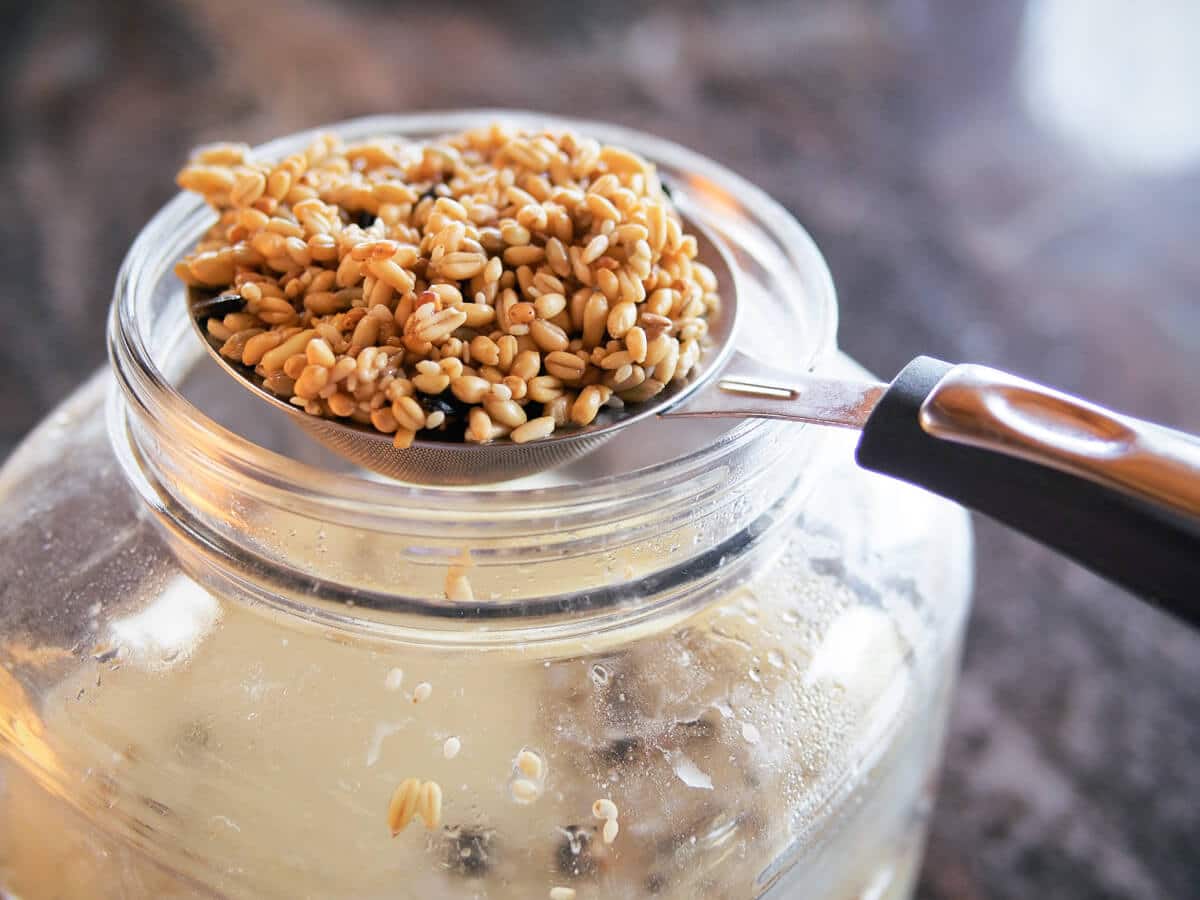
Gallon-Size Glass Jar | Mini Strainer
Every time I strain an amount of fermented feed from my jar, I add the same amount of dry feed back into it.
Give a stir, re-cover with a lid, and strain more feed the next day. This is the easiest way to keep your lacto-fermentation going without starting over.
You can keep reusing the same liquid, especially since it already has all that good bacteria floating around in it, which speeds up the fermentation of new grains.
In my setup at home, I keep a jar of pre-mixed grains right next to my jar of fermented feed. This makes it simple to refill the ferment jar with new grains each time I scoop some out of the liquid.
The jars sit on a dark shelf in my kitchen, where the temperature typically hovers around 68°F to 70°F.
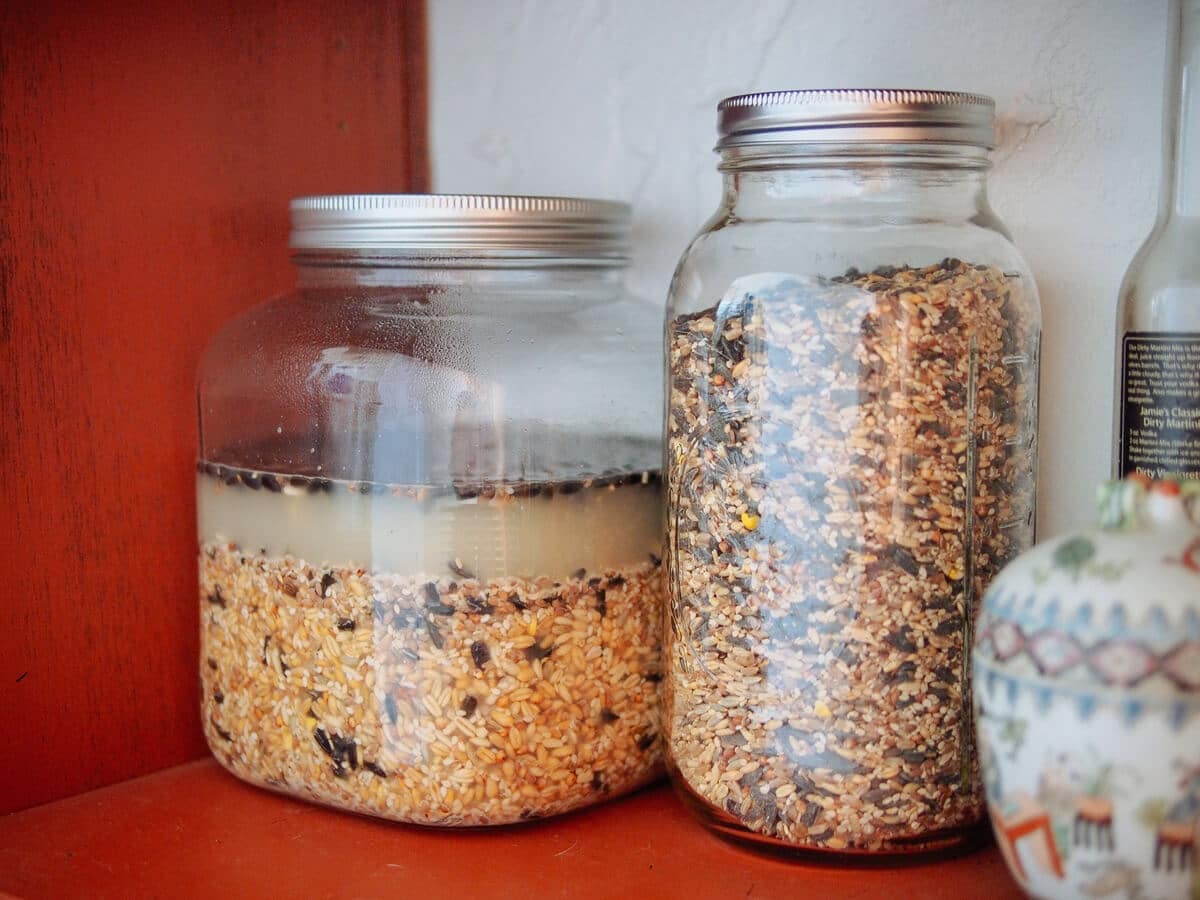
What I’ve Learned In the Last Year
In theory, you can reuse the ferment liquid indefinitely and it will just get better and better (and by better, that means it will contain an amazing amount of probiotic bacteria).
But I’ve started new batches of fermented feed a few times now, usually when I go out of town for at least a week and don’t want the feed to turn too sour.
I haven’t had enough experience with reusing my ferment liquid for more than a couple months at a time, but if yours becomes slimy, sludgy, or stinky (a side effect of oxygen killing the good bacteria and introducing the bad bacteria), you should start again with fresh water.
I have never used a starter to start the lacto-fermentation, and you don’t have to either. Lactobacilli is already present in the air and on the surfaces of the grains, and in the right environment they’ll proliferate before you know it.
At most, your feed will be fermented by day four. I’ve read accounts from other people who add unpasteurized apple cider vinegar as a starter but I think it’s unnecessary.
Vinegar contains acetic acid bacteria. We want lactic acid bacteria. While acetic acid has its own health benefits (and certainly won’t hurt if you decide to add a tablespoon or so to your chickens’ water or feed), it’s not useful as a starter for lacto-fermentation.
If you’re really impatient and want to get going right away, you can use the liquid from lacto-fermented pickles or sauerkraut to start your fermentation.
At feeding time, I bring the chickens a scoop or two of fermented feed and clear the dish when it’s empty.
I don’t leave fermented feed out for a long period of time, as the bacteria is most beneficial when it’s served fresh. Only leave enough feed out that your chickens can finish within half an hour.
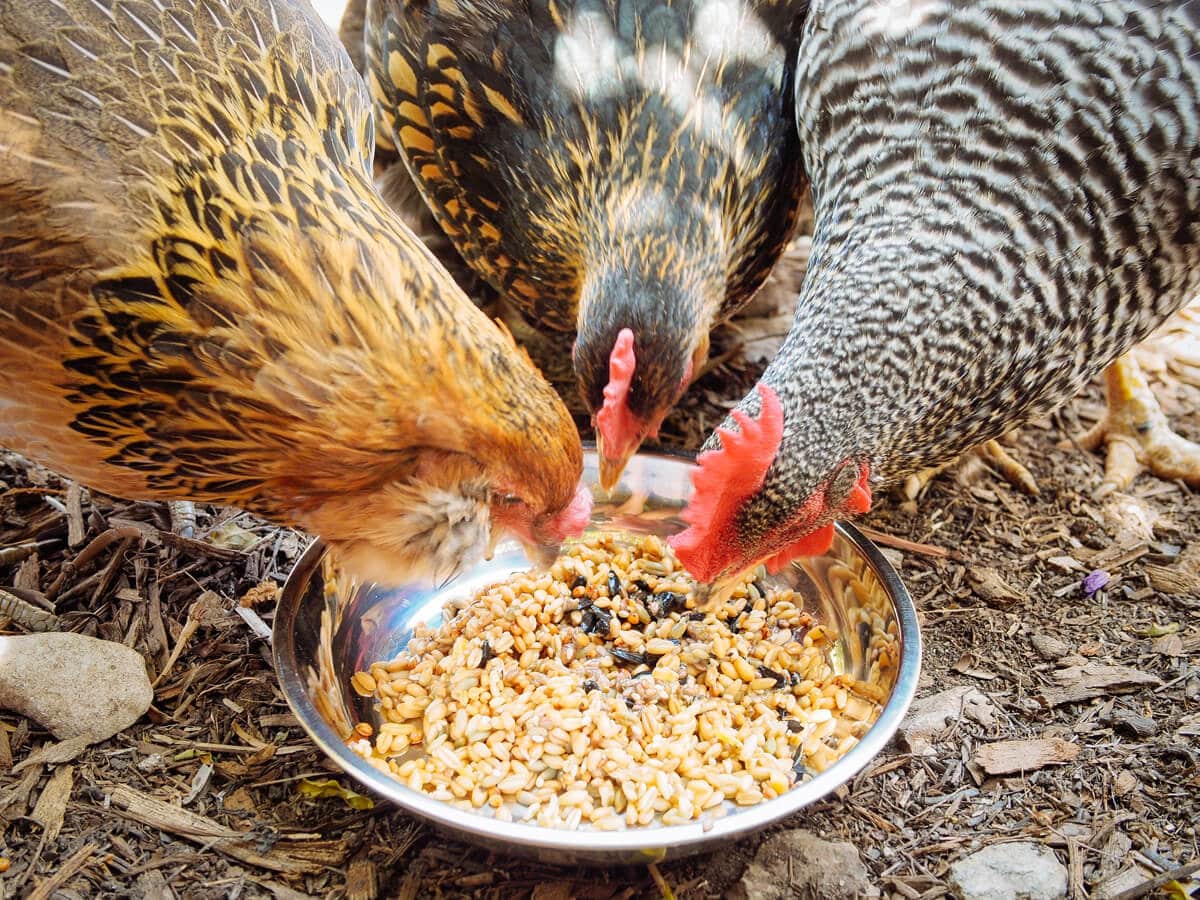
When I confine my chickens to their run all day (no foraging or treats), I’ve estimated that each one eats about one cup of dry feed per day.
When I give them fermented feed, it seems they eat half that amount. At the end of the day, their crops are nice and full.
While this is no scientific study on how much less they’re eating of the wet versus dry feed, I think it’s safe to say they do eat less feed when it’s fermented.
I don’t give fermented feed to my chickens every day. This is mostly because I’m not always home, and lack the time and resources to bring them fresh feed every day.
But I also believe in balance when it comes to food. While I’ve yet to come across any reports of someone getting sick from consuming too many probiotics, I feel moderation is best
Most of us don’t eat fermented foods as our main course every day, and our chickens probably shouldn’t either.
I still provide fresh greens and dried mealworms (along with grit and oyster shells) when I give my chickens fermented feed. I still provide their regular dry feed a few days a week, especially when I go out of town.
I’d say that right now, they average half a week with fermented feed and the other half with dry feed. Either way, they are as happy and healthy as can be!
Fermenting Sources
[show_shopthepost_widget id=”3323298″]















